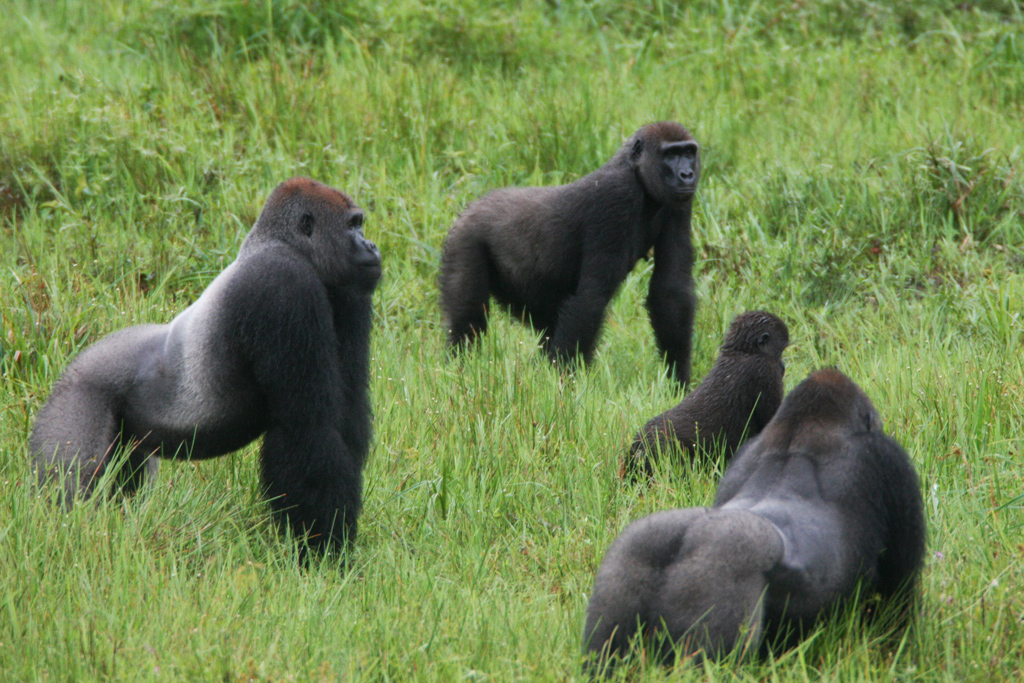Interspecific Interactions between Sympatric Apes
Categories: Journal no. 66, Behaviour, Other countries, Other protected areas, Western Lowland Gorilla
Gorillas live sympatrically with chimpanzees in most of their distribution area, but there are only a few sites where both species have been habituated to the presence of researchers and can be observed by them. Usually interactions between these ape species have been characterized as avoiding competition or as competition over food sources. Lowland gorillas in western Africa eat more fruits than eastern gorillas and therefore their diet shows a higher overlap with the one of chimpanzees than in their eastern counterparts.
In a new study, a total of 33 documented interspecific interactions (and two other unpublished interactions) at eight sites were found in published reports from studies conducted between 1966 and 2020. There is some evidence that foraging western lowland gorillas and chimpanzees spend more time in proximity during times of fruit abundance and less time during fruit scarcity. Sharing of tree crowns by both species was observed in Ndoki. In contrast, scientists reported two observations of lethal attacks of chimpanzees on immature gorillas in Gabon.
While the authors followed chimpanzees and gorillas during their own studies from 1999 to 2020 in the Goualougo Triangle, Ndoki Forest, they observed an additional 285 interspecific associations between the ape species. Research teams following chimpanzees in of a certain community observed 206 interspecific associations with gorillas.
Both species responded to alarm calls of the other species. No predation attempts between the species were observed, but aggressive threats and contact aggression between them. Instead of staying close to the silverback as protection, juvenile and subadult gorillas regularly travelled more than 300 m from their group to join a chimpanzee party.
Feeding together at the same food source represented one third of interspecific associations and despite the extreme rarity of figs in the region, these fruits were consumed during two thirds of the observed cofeeding events.
The authors concluded that there is a greater diversity of interactions than previously documented among sympatric apes, including social relationships between members of different species that persisted over years. In contrast to predictions of competition, nearly all interspecific associations were tolerant or affiliative. Members of the gorilla group were even integrated in a social network with the chimpanzees that included repeated association and interactions.
On some occasions, part of the gorilla group would climb into the tree crown to feed with chimpanzees while others remained on the ground and ate fallen fruit. Occasionally young gorillas and chimpanzees seeked out particular partners at food sources to engage in bouts of play. Subadults were observed to engage in interspecific play, but these social dynamics seemed to shift as they matured to adulthood.
Interactions between apes may differ depending on where they occur in the species' respective home ranges. Both species have core areas that are surrounded by peripheral zones which are visited less frequently and tend to have more aggressive interactions than core areas.
Such interspecific contacts may also have negative consequences. Disease transmission may result from association and affiliative behaviour - during direct physical contact between individuals during play, aggression, and sexual interactions. Moreover, gorillas were observed feeding on fruit that had been fed upon and discarded by chimpanzees and they foraged on fruits under areas where chimpanzees had foraged, urinated, and defecated.
Summary of
Sanz, C. M., Strait, D., Eyana Ayina, C., Massamba, J.-M., Ebombi, T. F., Ndassoba Kialiema, S., Ngoteni, D., Mbebouti, G., Rostand Koni Boue, D., Brogan, S., Funkhouser, J. A., Morgan, D. B. (2022): Interspecific interactions between sympatric apes. iScience 25, 105059

